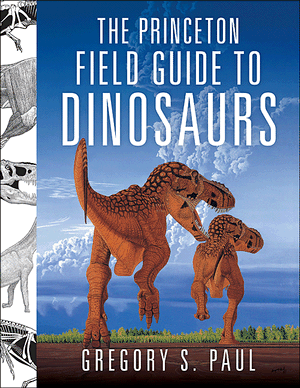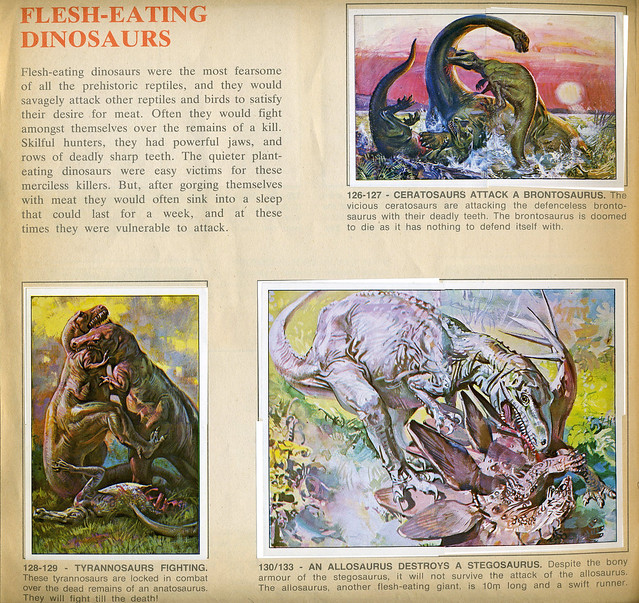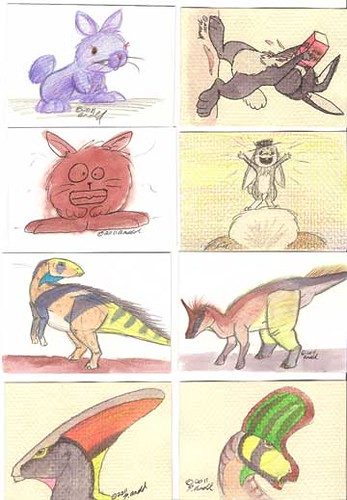In the build up to our Hadrosaur gallery we've seen two ART Evolved members take drastically different approaches to their pieces, both consciously engaging and taking to heart one of Gregory Paul's key demands. The thing is our two members have taken diametrically opposite positions on Paul's ultimatum.
We are wondering what you think about the whole mess?

The two members in question are Zach Miller and myself Craig Dylke. For the record, this post and what we are about to discuss is NOT a fight between the two of us. Zach and I have had a laugh or two discussing it on Facebook, so there is no ill will or a grudge to be read in this post (at least between us. Towards Mr. Paul on the other hand well...)
Our two "conflicting" artworks above, are reactions to Gregory Paul's recent rants about people referencing his own work. Zach has responded to Paul's demands in a very classy fashion, whereas I have reacted in a far more vindictive and combative one (these negative emotions being against GSP mind you, not Zach!).
If you missed the whole Gregory Paul "email incident" a month ago on the Dinosaur Mailing List here are the links to the original posts here, here, and here. The specific line me and Zach both specifically fixated on is:
"I am going to have to regretfully require that other artists either stop
using my materials as source material and do entirely original restorations from beginning to end, or make arrangements to provide compensation if they do so when engaging in commercial projects." -Gregory Paul
How does one respond to such a demand?
If you are Zach you do the classy thing and do exactly what Mr. Paul has demanded of you. I think this speaks highly of Zach's character, and definitely proves he is a better person on this score than myself. I don't take this gracious route (as you shall see).While constructing his Hadrosaur Zach approached it with a "No Greg Paul skeletals were referenced for the production of this illustration" policy. Zach has even wants to go the one step further and get an online movement towards this trend, and make it a meme.
In the long-term I think this is a insidiously effective and brutal attack on Mr. Paul. If Zach is successful down the road no one will purchase Mr. Paul's books, no one will reference his papers, and everyone will snuff out the GSP skeletal pose. Boiled down Mr. Paul will be eradicated from Palaeo-art and thus Palaeotology in general. Powerful stuff. Especially as this is not Zach being evil, but simply him doing what Mr. Paul has asked of him. In scientific illustration referencing is the key, and to not be referenced is death...
If you want to get back at Mr. Paul, especially for his rather bad behaviour in the emails (again you need to read them all. I am only really presenting the parts relevant to my current essay here), than please engage in Zach's online campaign, and join this meme. You, like Zach, are a long term thinker, and your patience may be the ultimate response to Mr. Paul's ultimatum.
Sadly I am not that patient a person. I don't do long term response. I'm an immediate action sort of person. More to the point I take extreme issue with what Mr. Paul has demanded of me. While Zach has been a honourable person and approached Mr. Paul's emails as though they are from a sane and rational point of view, I personally do not.
You see I do not agree with Mr. Paul's ultimatum in the quote above, and in fact find what he has said an utter lie attempting to bully other people out of palaeo-art! That is right Mr. Paul if you are reading I have called you a bully, a liar, and I'll add a hypocrite. Before I retract these accusations I require a coherent (unlike the nonsense you spouted off in your emails) response to the following:
You seriously claim ownership of a "reference" (especially for a real animal like a Dinosaur)?!?
The philosophic ramifications of Mr. Paul implying you can own a reference are staggering. I'm not sure he actually understands what the word reference actually means.The whole point of a reference is it is something one refers too, not copies or rips off. If you use something as a reference you should be merely looking to this source for a vague inspiration or an idea to guide your own work. If your finished work at the end looks just like your reference, than you haven't actually referred to your source, you have copied it.
If not for his comment quoted above and a few others throughout his emails, I would swear Mr. Paul seems to have confused the word referencing with the word plagiarising (plagiarism being something I'm not advocating!).
When any artist tries to capture the illusion of the real world in art, they need references. Whether these be someone elses work (photographs, paintings, sculptors, etc) or just the world around them and experiences in it, being a reference does not take a tangible form. So to claim we can't reference one specific set of works is ludicrous, as whether we mean to or not, artists reference everything around them! The whole world is our reference, why not your pictures too?
Mr. Paul's counter:
But some have disagreed, and are basically saying that those who go to
tremendous effort to build up a body of technical artistic work have to allow
all others to derive much of their art from that work. This is based on the idea
that accurate restorations are the “truth” like photographs of lions and
elephants. This is errant for legal and practical reasons. Starting with no one
has to do work restoring living animals.
If you have as thoroughly researched a Dinosaurs skeleton as you claim Mr. Paul, than YES your skeletals are as much a " 'truth' " as a photograph of a real animal is! Dinosaurs were real animals, and as of such Mr. Paul you can not claim to own any part of them... Their proportions and bones won't change no matter who is looking at them.
For those bones you've filled in for missing ones, you did this as a SCIENTIFICALLY educated guess, and not an artistic expression. The instant you present this as research and science it becomes part of that " 'truth' " stuff again. You might be wrong about the reconstruction in the end, but at the time you made it, this was your scientific hypothesis as to what the animal looked like.
This is all really giving more than a tiny bit of credit to Mr. Paul's concept of being able to own a reference in the first place!
Why is it okay for you to reference someone elses work, but I can not reference yours?!?
One of the key things that bugs me about Mr. Paul's demands, is that he implies he is reference-free in his skeletals. Yet follow my logic here, if you look at a fossil (even to the point of precisely measuring it) you would still be referring to the actual fossil, yes?I've already done a satirical post on my thinking in this regard, but I wanted to flesh it out here in more detail. Paul is claiming that because he referenced an actual fossil (in theory... in this post I am NOT taking his word for that!) he is not on the hook for this compensating the referee.
How exactly does that work?!? If he doesn't have to pay, why do I? If he was paying, than really shouldn't I be paying the institution that owns the fossil in the first place, since I'm referencing a referral of their reference (see the rather stupid chain of causality this is leading to!)?
However I'm challenging Mr. Paul's claim that he directly looks at every single fossil in the first place! I know as a matter of fact Mr. Paul has not been to an Alberta in a very long time (or if he has no one saw him come and take careful measurements of our bones, and I know a LOT of people in Alberta Palaeontology. We're pretty sure we would have seen you visit if you were properly measuring bones Greg).
So this particular half serious statement, half joke on Mr. Paul's part is frankly somewhat insulting with this in mind:
Before I rush off to compensate Mr. Paul, I want to see his proof that every single one of his skeletals is based solely off the original fossils, and than the receipts from him compensating all the owner of these fossils he referenced.Then does that not lead to a slippery slope in which any published images including the bones published in technical paper are out of bounds, forcing anyone who wishes to illustrate dinosaurs to go to exhibits and take their own photos of the bones? Of course this is obviously true. So you all beef up your travel budgets!
-Gregory Paul
However I'm not dumb, and can easily tell that if Mr. Paul hasn't visited all the museums housing the specimens he is reconstructing, he must be getting his own references from somewhere. Sadly for Mr. Paul, he tells me exactly where in his emails harping on me for referencing his hard skeletal work...
As far as I know no scientist objects to the images of skeletal elements and mounts that appear in their academic publications being used by illustrators. If any do, they can mention it in the their papers. -Gregory PaulUh Greg, the scientists don't put it there because they doesn't care, but because they know they can't. Scientists are super smart people who not only know how to interprete fossils, but also that they don't own the reference to said fossil.
The kicker is one can easily picture Mr. Paul sitting there pilfering all the "objection" free skeletal references in academic papers, and thinking to himself how clever he is finding this loophole the scientists have left for him. At least I hope he is that stupid. Otherwise he really is a douche for presenting his case as anything different from these scientists.
You imply I have not compensated you for use of your work as a reference, despite the fact I bought it!?!
We now come to my final, and most enraged point. Mr. Paul presents his case as though all of us out here who have gotten our hands on his skeletals have somehow stolen them from him without his permission, and without compensating him for our possession of them.
Correct me if I'm wrong, but is not buying something a form of compensation?!?
The implication I am somehow stealing content from Mr. Paul is insulting. I would not have access to his skeletals had he not been offering them (for a price) in the first place! I have not even been getting them out of the library, borrowing them from a friend, or some other free means of accessing the book. I purchase the books and their content, and as of such I am free do to what I want with them and their contents so long as it is legal (in other words I do not directly reproduce their contents for a profit...), referencing being well within my rights.In fact referencing is all a book is there for. I reference the ideas within it, and that is why it exists. Whether the information we are accessing is intellectual or visual in the end the book exists only for us to reference!
So Mr. Paul the simple solution to your problem is as follows. Either charge us more money for these books OR alternatively (especially if you wish us not to reference your work at all) stop selling them to us!!! While I sympathize that the cost of producing a book is high,and that there isn't a lot of profit in being an author, the point is as a 20 year running author you should know this by now! If giving us access to your skeletals is hurting your art career that much and not making up for the lose, than stop making the books we're using!
 Perhaps the personal reason why I have found Mr. Paul's emails so insulting is the fact I had just purchased his Princeton Field Guide a month before he essentially yelled at me for doing so.
Perhaps the personal reason why I have found Mr. Paul's emails so insulting is the fact I had just purchased his Princeton Field Guide a month before he essentially yelled at me for doing so.
What really pisses me off about this, is that Mr. Paul knowingly released this the largest and most comprehensive collection of his skeletals to date, while having huge issues with people referencing his similar skeletals from his many other books of the past 20 years, and than have gumption to bitch about it all!!! It is as much have your cake and eat it too solution as you can get really from his point of view. Release a book that everyone Greg doesn't want having his stuff must have, let them buy it for a few months, and then once the market for it has dropped off attack those same people so they don't actually use the book.
So if I haven't fully made my case to you by now, than I shall leave with this one last illustration of Mr. Paul's dishonest claims and demands. In his email a few sentences after the initial "I am going to have to regretfully require that other artists either stop using my materials as source material" quote he stated this:
"For example, the restorations in The Princeton Field Guide to Dinosaurs are
copyrighted, and I note in the text that anyone who wishes to utilize them for
commercial purposes needs to first contact me. -Gregory Paul
So I hope I don't have to really explain why utilize and reference are not the same by this point. In his email Paul believes them to be the same, but of course they are not.
However I took him up on this statement in my copy of the Princeton Field Guide, and tried to find this "note" of his. My findings were quite amusing and yet disgusting at the same time.
On the publication page there is a Copyright by Gregory Paul 2010, but that is all. I read through the preface by Paul and found nothing about people using his art that alone contacting him personally. After that I could find no other sections in there by Paul that should address this topic (unless he snuck it into the body of the book somewhere else)
The only written line I could pertaining to using Paul's skeletals (overall content really) in the whole book was this from the publication page:Once again am I missing something here or is this man a lying douche? In that previous quote I shared with you, Mr. Paul directly claimed this preamble should have been by him and about him, rather than Princeton University Press. This to me calls into question just how much personal ownership he has over the material in the Field Guide in the first place."Requests for permission to reproduce material from this work should be
sent to Permissions, Princeton University Press." -Princeton University
Press
That being besides the case, notice how Princeton only demands you approach them if you "reproduce material" from the book, rather than reference material. Hmmm maybe because much like the aforementioned scientists in this essay, Paul's publishers know they can't claim rights on people referencing the book.
So what are your thoughts on this rather large, and in my opinion outrageous topic?









 So without further ado here are the
So without further ado here are the  A
A 

 Love in the time of
Love in the time of 






 Sadly a mere two weeks after we launched this delay trial, we have already
Sadly a mere two weeks after we launched this delay trial, we have already 





 The most urgent (in that it has a deadline) is
The most urgent (in that it has a deadline) is 






















